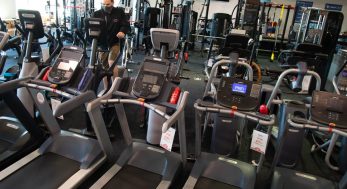
VideoGyms040820 A LCO
Bangor, Maine — April 8, 2020 — Katie Norwood, a trainer at Wilcox Wellness & Fitness in Bangor, instructs a virtual training session via Zoom on Wednesday. Norwood instructed the class from the empty gym, where only she and one other trainer, who was giving a private virtual training session, were present. After demonstrating an exercise, Norwood watches her clients for proper form and gives encouragement as they go through the workout. (Linda Coan O’Kresik)
Bangor, Maine — April 8, 2020 — Katie Norwood, a trainer at Wilcox Wellness & Fitness in Bangor, instructs a virtual training session via Zoom on Wednesday. Norwood instructed the class from the empty gym, where only she and one other trainer, who was giving a private virtual training session, were present. After demonstrating an exercise, Norwood watches her clients for proper form and gives encouragement as they go through the workout. (Linda Coan O’Kresik)
Sam Schipani, Bangor Daily News Staff • May 14, 2020
Maintaining your health is about more than just not contracting a deadly disease — even during the pandemic. But as the stay-at-home orders have dragged on, many of us have let our daily physical activity slide, which compromises our physical health in other ways. It’s time to change that.
Share or Comment
Maintaining your health is about more than just not contracting a deadly disease — even during the pandemic. But as the stay-at-home orders have dragged on, many of us have let our daily physical activity slide, which compromises our physical health in other ways. It’s time to change that.
“Almost all chronic diseases are related to inactivity,” said Jay Polsgrove, associate professor and coordinator of the Exercise Science Program at Husson University. “When you do exercise [and] elevate things for a specified period of time for a short duration, that’s when you get the health benefits.”
But while that might have meant turning to the gym in the past, that’s not possible right now in many cases. On May 11, some gyms and fitness centers in Maine could reopen for one-on-one personal training and outdoor fitness classes with fewer than 10 participants. But gyms in general won’t reopen until June 1, during Phase Two of Maine’s reopening plan.
Polsgrove and James Graves, professor of exercise, health and sport sciences at University of Southern Maine, agreed that the best thing anyone can do when it comes to exercise is keep exercising regularly, even if you have fallen off of your usual fitness routine. After all, it is harder to get back on the fitness bandwagon the longer you wait between workouts.
Here’s how to start incorporating exercise back into your life.
Stand up
Seriously — especially if you are working from home, the beginning to being healthier could be as simple as standing up and walking around the house or down the block every hour.
“Try to find ways to be more active in your day,” Polsgrove said. “If you can build time into your day that you can get the body moving and blood circulating, that does have a big benefit.”
Find something you enjoy
Whether it’s running, rollerblading, jumping rope or doing yoga, find some sort of physical activity that makes you smile while you do it.
“If you don’t enjoy doing it you’re not going to stick with it,” Graves said.
Similarly, if the work out doesn’t make you feel good because it is too intense, ease up and adjust to make sure you are still enjoying your daily workouts.
“If you exercise at an intensity that is uncomfortable, you’re less likely to do it again,” Graves said. “Make sure you’re having fun, [though] it’s ok to push your limits a little bit.”
Mix it up
A variety of workouts will help you maintain good physical fitness. Graves referred to the American College of Sports Medicine guidelines for the recommended quantity and quality of physical activity in healthy adults, including 30 minutes of aerobic kinds of activity 5 days a week, some strength training to build and maintain muscles mass and exercises for flexibility.
“We know that physical activity is important for everyone,” Graves said. “You’ve got to mix it up. Do something for muscles and bones, and a little bit of flexibility and balance. It’s important to participate in a well-rounded exercise program.”
Polsgrove said he plays a game with his week of workouts, where he sets a rough outline of his workout goals for the week and lets the weather decide what the workout will be for the day. For example, if it is nice outside, he will jog; if it is cloudy, he will lift weights.
Exercise in bursts
Think you don’t have time to exercise? Graves said that inserting short bursts of exercise throughout the day is not only effective to maintain your physical health, but it can also help break up the long days in quarantine.
“You don’t have to do it all at once,” Graves explained. “We know that three bouts of exercise that last 10 minutes each is equally as beneficial as one bout of 30 minutes. You can break up your routine [with] things you enjoy doing.”
If you don’t know where to start, try your stairs.
“There’s nothing wrong with walking some stairs,” Graves said. “Do that for 10 minutes, three times a day, and that’s 30 minutes of aerobic physical activity. I’m not going to walk up and down my stairs for an hour, but I can do that for 10 minutes.”
Use what you’ve got
Likewise, there are other ways to use what you have to stay fit — even if you are in a small space or don’t have stairs.
“Just about anything that provides resistance or weight can be used in place in dumbbells or barbells,” Graves said. “You can fill milk [jugs] with water — those weigh about 12 pounds each. There are a lot of instructional videos about that. There are [also] exercises that you can do using furniture in your house.”
If your living quarters are especially cramped, try exercising outside (safely, of course — Graves said to always bring a mask with you).
Make a ritual out of exercise
Science shows that rituals help with motivation. Polsgrove said that he has a ritual for setting up his in-home exercise environment, where he moves chairs out of the way, puts his mats down, sets weights up and puts on upbeat music.
“It feels like you’re transitioning to an exercise environment,” he said. “Make it a formal time of the day. If it’s informal, it’s easy to drift on to doing something else.”
Setting a specific time and recording the activity you have done that day can also help set up the habit in your mind.
“Sometimes people like journaling or keeping track of what they did,” Polsgrove said.
Work out (even virtually) with a buddy
Polsgrove and Graves both recognized that the lack of a social element is making working out extra challenging.
“That social component is an important motivator, and that’s especially challenging now because we’re being asked to avoid each other,” Graves said. “Given the requirement for social distancing it’s even harder now to get motivated to participate.”
Finding a buddy to workout with you, even if it is virtually over video chat, will motivate you to stick to your plan to workout. Polsgrove said that he uses a similar tactic for his personal training clients.
“When I’m doing personal training with people I get them in a contract agreement [about] when are the days that you can exercise [and the] times of day,” Polsgrove said. “Create obligations that you and a friend are going to meet at a certain time.”
Go online
When it comes to workout videos, Graves said that there are seemingly limitless possibilities online. He said that some yoga, pilates and other fitness instructors have moved classes online for a small subscription fee, but there are also a number of free resources.
Figuring out how to make exercise work for a sheltering-in-place is not only a good way to stay healthy now and for potential future lockdowns, but also to incorporate fitness back into your daily life in general.
“It gives us strength and resolve for the future, trying to become more organized and have a better understanding of what exercise means to us,” Polsgrove said. “Creating a home routine that you can have when you aren’t able to go to the gym is meaningful [to have] for the future.”
Share or Comment
Thank you for reading your 4 free articles this month. To continue reading, and support local, rural journalism, please subscribe.

